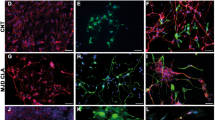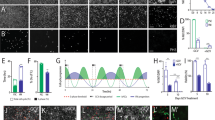Abstract
Fetal grafts of normal cerebellar tissue were implanted into the cerebellum of Purkinje cell degeneration mutant mice (pcd/pcd), a model of adult–onset recessively inherited cerebello–olivary atrophy, in an attempt at correcting their cellular and motor impairment. Donor cerebellar cells engrafted in the appropriate sites, as evidenced by the pattern of expression of insulin–like growth factor–1 (IGF–I) system genes. Bilateral cerebellar grafts led to an improvement of motor behaviors in balance rod tests and in the open field, providing evidence for functional integration into the atrophic mouse cerebellum and underscoring the potential of neural transplantation for counteracting the human cerebellar ataxias.
This is a preview of subscription content, access via your institution
Access options
Subscribe to this journal
Receive 12 print issues and online access
$209.00 per year
only $17.42 per issue
Buy this article
- Purchase on Springer Link
- Instant access to full article PDF
Prices may be subject to local taxes which are calculated during checkout
Similar content being viewed by others
References
Harding, A.E. Clinical features and classification of inherited ataxias. in Inherited Ataxias (eds. Harding, A.E. & Deufel, T.) 1–14 (Raven, New York, 1993).
Holmes, G. A form of familial degeneration of the cerebellum.Brain, 30 467–489 (1907).
Poirier, J., Gray, F. & Escourolle, R. Manual of Basic Neuropathology 151–157 (Saunders, Philadelphia, 1990).
Mullen, R.J., Eicher, E.M. & Sidman, R.L. Purkinje cell degeneration, a new neurological mutation in the mouse. Proc. Natl. Acad. Sci. USA 73, 208–212 (1976).
Landis, S.C. & Mullen, R.J. The development and degeneration of Purkinje cells in fed mutant mice. J. Comf. Neural. 177, 125–144 (1978).
Ghetti, B. & Triarhou, L.C., Purkinje cell degeneration mutant: A model to study the consequences of neuronal degeneration. in Cerebellar Degenerations: Clinical Neurobiology (ed. Plaitakis, A.) 159–181 (Kluwer Academic, Boston, 1992).
Dunnett, S.B. & Bjorklund, A. (eds.) Functional Neural Transplantation (Raven, New York, 1994).
Das, G.D. & Altman, J. Transplanted precursors of nerve cells: Their fate in the cerebella of young rats. Science 173, 637–638 (1971).
Wells, J. & McAllister, J.P. The development of cerebellar primordia trans-planted to the neocortex of the rat. Dev. Brain Res. 4, 167–179 (1982).
Alvarado-Mallart, R.M. & Sotelo, C. Differentiation of cerebellar anlage hetero-topically transplanted to adult rat brain: A light and electron microscopic study. J. Comf. Neural. 212, 247–267 (1982).
Sotelo, C. & Alvarado-Mallart, R.-M. Growth and differentiation of cerebellar suspensions transplanted into the adult cerebellum of mice with heredodegen-erative ataxia. Proc. Natl. Acad. Sci. USA 83, 1135–1139 (1986).
Triarhou, L.C., Low, W.C. & Ghetti, B. Transplantation of cerebellar anlagen to hosts with genetic cerebellocortical atrophy. Anat. Embryol. 176, 145–154 (1987).
Sotelo, C. & Alvarado-Mallart, R.M. Reconstruction of the defective cerebellar circuitry in adult Purkinje cell degeneration mutant mice by Purkinje cell replacement through transplantation of solid embryonic implants. Neuroscience 20, 1–22 (1987).
Triarhou, L.C., Low, W.C. & Ghetti, B. Intraparenchymal grafting of cerebellar cell suspensions to the deep cerebellar nuclei of pcdmutant mice, with particular emphasis on re-establishment of a Purkinje cell cortico-nuclear projection. Anat. Embryol. 185, 409–420 (1992).
Gardette, R., Alvarado-Mallart, R.M., Crepel, F. & Sotelo, C. Electrophysio-logical demonstration of a synaptic integration of transplanted Purkinje cells into the cerebellum of the adult Purkinje cell degeneration mutant mouse. Neuroscience 24, 777–789 (1988).
Triarhou, L.C., Low, W.C. & Ghetti, B. Serotonin fiber innervation of cerebellar cell suspensions intraparenchymally grafted to the cerebellum of pcdmutant mice. Neurochem. Res. 17, 475–182 (1992).
LeRoith, D. et al. Insulin-like growth factors in the brain. in Neurotrophic Factors (eds. Loughlin, S.E. & Fallon, J.H.) 391–114 (Academic Press, San Diego, 1993).
Hepler, J.E. & Lund, P.K. Molecular biology of the insulin-like growth factors: Relevance to nervous system function. Mol. Neurobiol. 4, 93–127 (1990).
Torres-Aleman, I., Pons, S. & Arevalo, M.A. The insulin-like growth factor I system in the rat cerebellum: Developmental regulation and role in neuronal survival and differentiation. J. Neurosd. Res. 39, 117–126 (1994).
Nieto-Bona, M.P., Garcia-Segura, L.M. & Torres-Aleman, I. Orthograde transport and release of insulin-like growth factor I from the inferior olive to the cerebellum. J. Neurosci. Res. 36, 520–527 (1993).
Bondy, C.A. Transient IGF-I gene expression during the maturation of functionally related central projection neurons. J. Neurosci. 11, 3442–3455 (1991).
Bondy, C.A. & Lee, W.-H. Developmental and injury-induced patterns of IGF and IGF receptor gene expression in the brain: Functional implications. Ann. N.Y. Acad. Sci. 692, 33–43 (1993).
Bondy, C., Werner, H., Roberts, C.T. & LeRoith, D. Cellular pattern of type-I insulin-like growth factor receptor gene expression during maturation of the rat brain: Comparison with insulin-like growth factors I and II. Neuroscience 46, 909923 (1992).
Lee, W.-H., Javedan, S. & Bondy, C.A. Coordinate expression of insulin-like growth factor system components by neurons and neuroglia during retinal and cerebellar development. J. Neurosci. 12, 4737–744 (1992).
Bondy, C. & Lee, W.-H. Correlation between insulin-like growth factor (IGF)-binding protein 5 and IGF-I gene expression during brain development. J. Neurosci. 13, 5092–5104 (1993).
Bondy, C.A., Bach, M.A. & Lee, W.-H. Mapping of brain insulin and insulin-like growth factor receptor gene expression by in situ hybridization. Neuroprotocols 1, 240–249 (1992).
Lee, W.-H., Michels, K.M. & Bondy, C.A. Localization of insulin-like growth factor binding protein-2 messenger RNA during postnatal brain development: Correlation with insulin-like growth factors I and II. Neuroscience 53, 251–265 (1993).
Sokal, R.R. & Rohlf, F.J. Biometry, 2nd edn. (Freeman, New York, 1981).
Castro-Alamancos, M.A. & Torres-Aleman, I. Long-term depression of gluta-mate-induced y-aminobutyric acid release in cerebellum by insulin-like growth factor I. Proc. Natl. Acad. Sci. USA 90, 7386–7390 (1993).
Lee, P.O., Conover, C.A. & Powell, D.R. Regulation and function of insulin-like growth factor-binding protein-1. Proc. Soc. Exp. Biol. Med. 204, 4–29 (1993).
Obata, K. GABA in Purkinje cells and motoneurons. Experientia 25, 1285 (1969).
Thach, W.T., Kane, S.A., Mink, J.W. & Goodkin, H.P. Cerebellar output: Multiple maps and modes of control in movement coordination. in The Cerebellum Revisited (eds Llinas, R. & Sotelo, C.) 283–300 (Springer-Verlag, New York, 1992).
Yuasa, S., Kawamura, K., Ono, K., Yamakuni, T. & Takahashi, Y. Development and migration of Purkinje cells in the mouse cerebellar primordium. Anat. Embryol. 184, 195–212 (1991).
Wetts, R., Moran, T., Oster-Granite, M. & Gearhart, J. Effect of Purkinje cell loss on complex motor behavior. Soc. Neurosci. Abstr. 11, 1037 (1985).
Caddy, K.W.T. & Biscoe, T.J. Structural and quantitative studies in the normal C3H and Lurcher mutant mouse. Philos. Trans. R. Soc. Land. B. Biol. Sci. 287, 167–201 (1979).
Mullen, R.J. & La Vail, M.M. Two new types of retinal degeneration in cerebellar mutant mice. Nature 258, 528–530 (1975).
Greer, C.A. & Shepherd, G.M. Mitral cell degeneration and sensory function in the neurological mutant mouse Purkinje cell degeneration. Brain Res. 235, 156–161 (1982).
O'Gorman, S. & Sidman, R.L. Degeneration of thalamic neurons in 'Purkinje cell degeneration' mutant mice. I. Distribution of neuron loss. J. Camp. Neural. 234, 277–297 (1985).
BureS, J., BuresovA, O. & Huston, J. Techniques and Basic Experiments for the Study of Brain and Behavior 37–89 (Elsevier Scientific Publishing Co., Amsterdam, 1976).
Jones, B. J. & Roberts, D.J. The quanitative measurement of motor incoordina-tion in nai've mice using an accelerating Rotarod. J. Pharm. Pharmacol. 20, 302–304 (1968).
Author information
Authors and Affiliations
Rights and permissions
About this article
Cite this article
Zhang, W., Lee, WH. & Triarhou, L. Grafted cerebellar cells in a mouse model of hereditary ataxia express IGF–I system genes and partially restore behavioral function. Nat Med 2, 65–71 (1996). https://doi.org/10.1038/nm0196-65
Received:
Accepted:
Issue Date:
DOI: https://doi.org/10.1038/nm0196-65
This article is cited by
-
Increases in GFAP immunoreactive astrocytes in the cerebellar molecular layer of young adult CBA/J mice
Laboratory Animal Research (2021)
-
Task Force Paper On Cerebellar Transplantation: Are We Ready to Treat Cerebellar Disorders with Cell Therapy?
The Cerebellum (2019)
-
The Ataxic Syrian Hamster: An Animal Model Homologous to the pcd Mutant Mouse?
The Cerebellum (2009)
-
Neurotrophic factors for the investigation and treatment of movement disorders
Neurotoxicity Research (2003)
-
Neural stem cell therapy for neurological diseases: dreams and reality
Nature Reviews Neuroscience (2002)



